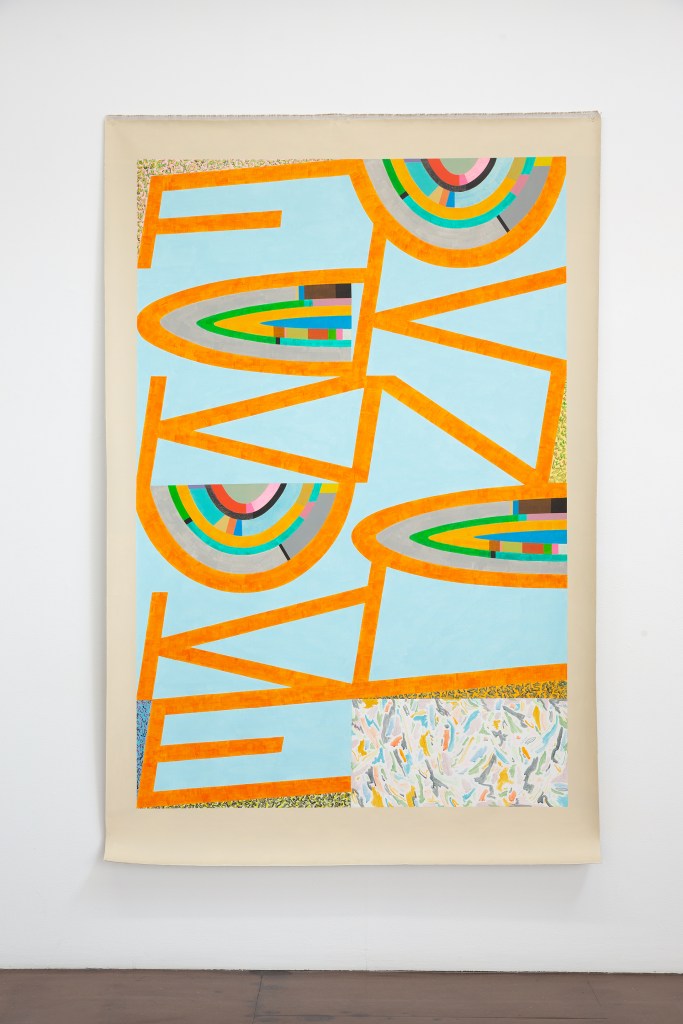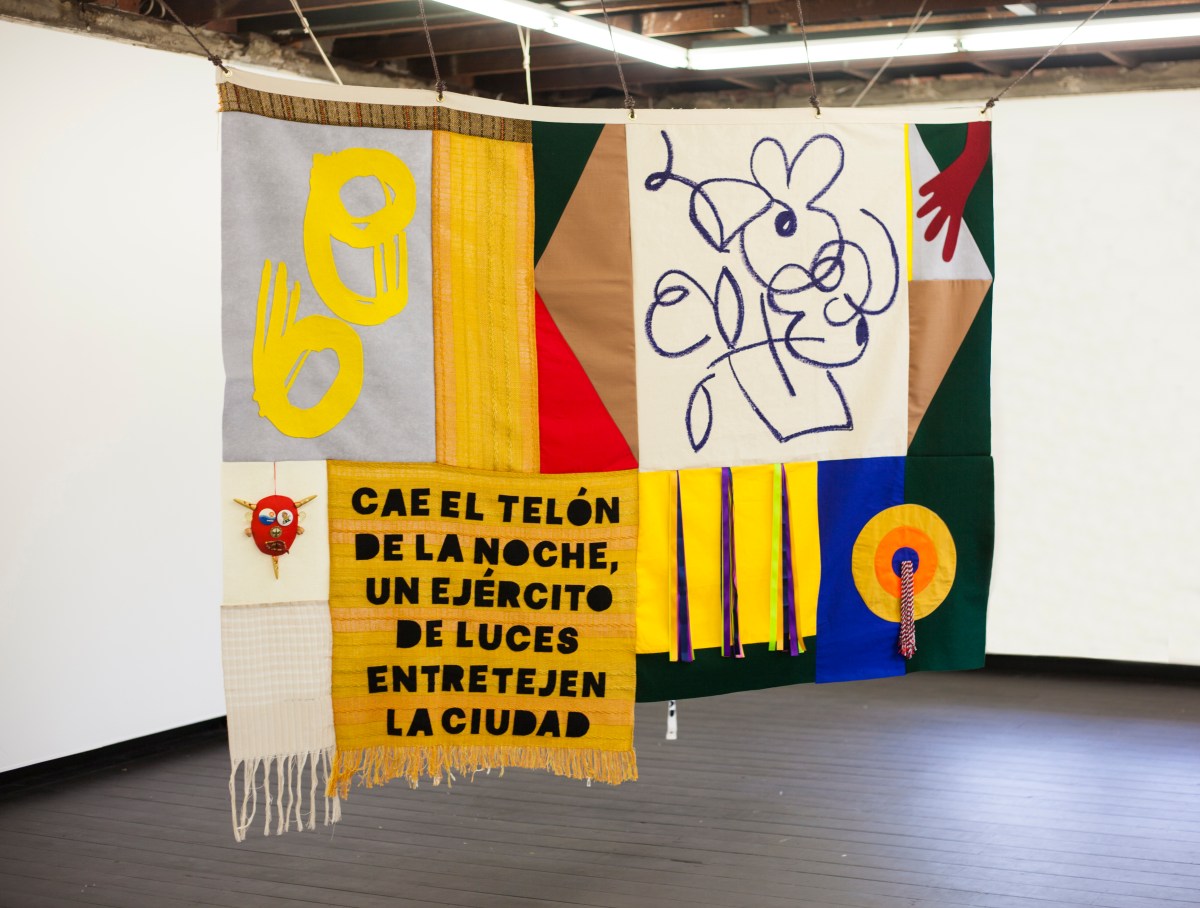Nadia Hernández and Jon Campbell are contemporary artists whose works reflect upon language and memory using a variety of media. Their exhibition, Speech Patterns, is currently on display at the Art Gallery of Western Australia. AGWA curator Robert Cook paired the two artists due to their shared themes of relocation, and a consistent emphasis on the marriage of text and image.
Campbell, who was born in Belfast and grew up in Melbourne, explores the contingencies of Australian culture with insight and humour. Hernández, who grew up in a Venezuelan valley surrounded by the Andes mountains, captures the everydayness of life using symbols and anecdotes connected with her past. Both artists access memory to encapsulate and express antithetical emotions, using both positive and negative space, with emphasis on words and meanings.

Campbell’s collection of paintings, prints and banners spans almost 40 years. Many of his recent pieces spell out their titles in literal letters. For example, Fuck Knuckle (2019, acrylic paint on unstretched linen) is large and bright, with its titular words spelled out discreetly in bright orange letters, hidden in plain sight by blue blocking and patterned highlights.
Sometimes the viewer must work to find the words, as in Fuck Knuckle and It’s a world full of lying bastards (2017, enamel paint on plywood), but sometimes it’s as obvious as reading a literal sign. For example, Campbell’s bright and spiky Undressing in public prohibited (2019, acrylic paint and watercolour pencil on unstretched cotton duck) references a photograph of a graffitied sign, and speaks of the contrasting values in Australian society – on one hand fresh and colourful – on the other, stark and stiff.
Campbell’s use of pattern and text is less present in his earlier pieces, painted between 1984 and 1986. Three juxtaposed enamel and oil scenes depict everyday life in the form of a Nolan-esque vehicle (Firetruck, 1984), a background-less backyard gathering (The Party, 1986) and a comparatively detailed snapshot (All the Boys, 1984), which depicts seven young men in a car.
These earlier artworks – heavily inspired by the styles and techniques of influential artists and mentors – invite the viewer directly into Campbell’s mind and memory. They provide literal interpretations of moments and figurative explorations of concepts, standing out as unique among later works that include less subtext and more actual text.
Campbell’s Peace and Love (1991, acrylic paint, collage and pencil on cotton duck) is one of the earliest pieces on display to incorporate the written word. It depicts Campbell’s wife, Annie, in a boxer’s stance, with the letters of peace and love spelled across her fingers. Her peace hand has an extra digit to allow for every letter, but it doesn’t appear out of place in the striking artwork, which also features scenes of war beneath the woman’s feet.
Campbell’s use of song lyrics and phrases treats words like found objects. He looks for sounds that resonate with him, or that capture time, place, memory, meaning or politics. The ambiguity of Campbell’s meanings add extra layers labelled by curator Robert Cook, during the Speech Patterns artist talk, as being like a ‘cultural superego’.
Hernández has a vibrant body of textiles, papercuts and paintings displayed in this exhibition. With a background in performance poetry, fashion and graphic design, she finds beauty in everydayness, and this comes through strongly in her artistic practice. The text flowing through her work is written in Spanish, a choice related to Hernández’s desire to connect with relatives. She uses words to incite people to delve deeper into interpretation, but also to explore the particularity of dialect and reveal additional layers of meaning.
The sun is a recurring symbol/image in Hernández’s work, appearing in her 2020 papercut-style hanging textile, Como el sol y toda su energía – a colourful tribute to the artist’s grandmother – and El sol alumbra para todxs, el sol alumbra para todos, el, el sol, el sol, el sol el, alumbra para todxs (2020 oil on linen) – a comic-strip-style oil on linen that pays homage to the sun with loose lines, scrawled words and warm colours.
Una Flor con amo (2019, oil on linen) revels in a playful sparsity that complements the sunny optimism of nearby painting, Por la vida: el sol, como crece su amor (2020, oil on linen), which engages with positivity and more sun symbolism in an effort to counteract the feelings of helplessness prevalent during the pandemic.
Hernández combines pop culture elements with everyday objects suggested by people close to her – like peeking into the hive-imagination of a family – in her 2022 oil on linen work, Pinta flores, pinta aguacates, pinta un bodegón lleno de cosas que te gustan, pinta algo que hayas cocinado con tu madre, pinta… which is displayed besides two equally large-scale paintings of a similar tone.
Hernández’s work is rich in meaning, sometimes spelled out in words, and other times meted out in poetry and metaphor. In her 2019 oil on linen piece, Las matas en mi casa, golondrina viajera y citricos, Hernández reflects upon her wilted state being reflected in the condition of her house plants, whereas De mantequilla a temperatura ambiente (2021, oil and acrylic paint on cotton) speaks of the poetry the artist perceives in the everydayness of life – in this case, perceiving the melting of butter as a state of union, representing social change.
Read: Barbara Hepworth: tribute to a hard-won career
Hernández and Campbell are accomplished artists united by themes of relocation, identity, place, history and the power of words expressed through different visual mediums and styles. Masterfully curated and aesthetically resonant, this exhibition will impress and intrigue.
Speech Patterns
Art Gallery of Western Australia, WA
Curated by: Robert Cook
Artists: Nadia Hernández and Jon Campbell
Free Admission
Speech Patterns will be displayed at AGWA until January 8 2023.





